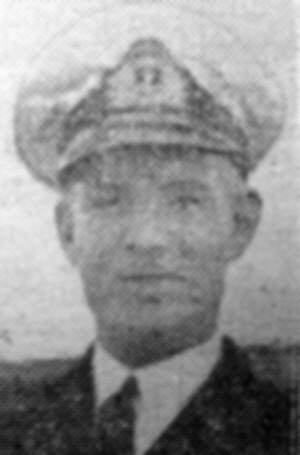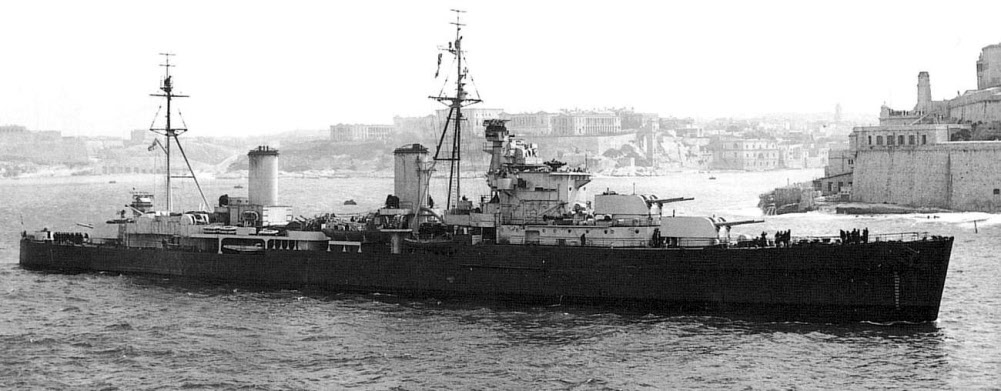
Royal Navy, HMS ‘Penelope’.
Francis Richard Vaile was born in the Melton Mowbray area of Leicestershire in early 1909. He was the eldest of four sons born by 1911 to Gloucester born railway porter Joseph Vaile and Lincolnshire born Henrietta Mason, who married near Bourne, Lincolnshire in early 1902. In 1911, the family were living at Wymondham, near Oakham in Lincolnshire. Given his father’s occupation as a railway worker, and Francis Vaile’s education at Ossett Grammar School, it is likely that the Vaile family lived at Ossett or Horbury during the pre-war years before 1939.
Francis Vaile’s father, Company Sergeant-Major Joseph Vaile died of wounds on the 5th July 1916 at the Battle of the Somme, whilst serving with the “Leeds Pals”, the 15th Battalion of the West Yorkshire Regiment (Prince of Wales’s Own). Henrietta Vaile never remarried and died aged 86 in the Pontefract area in 1962.
Francis Vaile married Evelyn Symons (born 20th September 1918) in the early months of 1936 at Devonport. They had two children: Jean E. Vaile, born 16th January 1937 and Roger Vaile, born on 6th December 1938, both births registered in Plymouth. In 1939 the two children, Jean and Roger were living at South View Cottages, Plymouth with two domestic servants, one of whom was Annie Symons, in the household. Other members of the Evelyn’s family, the Symons, were living a few doors away. Roger Vaile died in 1941 aged 2 years.
Evelyn Vaile was living at 1, South View Cottages, but no 1939 record of Francis Richard has been found and it is likely that he was away at sea. The 1939 Register indicates that Evelyn subsequently married a man called Norman G. Moore in the summer of 1964 in Plymouth, 20 years after the death of her first husband.
HMS ‘Penelope’ was an Arthura Class light cruiser and was built in Belfast at the Harland & Wolff shipyard in 1935. At 06:58 hours on the 18th February 1944, the unescorted HMS ‘Penelope’ under the command of Captain G.D. Belben, DSO, DSC, AM, RN, was hit in the aft engine room by one torpedo from German U-Boat U-410 whist steaming at 26 knots, 35 miles west of Naples. The cruiser sank immediately after being hit at 07:16 hours. The commander, 24 officers, 368 ratings and 24 Marines were lost, including Francis Richard Vaile.
The “Ossett Observer” had this obituary for Frank Vaile:1
“Netherton Naval Officer Missing – Served On The Famous ‘Pepperpot’ – Sub-Lieutenant Francis Richard Vaile (34), son of Mrs. and the late Mr. Joseph Vaile, 5, Council Villas, Netherton, is reported as ‘Missing, believed killed’. Educated at Netherton Council School and afterwards at Ossett Grammar School, where he obtained his school certificate and played football and cricket with the school teams, he joined the Navy when eighteen, receiving his training at Devenport. Since then he has seen service in all parts of the world, and when war broke out, he was posted to the cruiser ‘Penelope’. This was the famous cruiser affectionately known as ‘H.M.S. Pepperpot’, because at one time she had two thousand splinter holes through being bombed most incessantly at Malta. She helped many vital convoys through to Malta and took part in an action that saw the sinking of nine enemy supply ships and a big tanker. During one period of seventeen days, fourteen torpedoes and 3,000 tons of bombs were launched against her by nearly 1,000 German and Italian aircraft. The sinking of the Penelope was officially announced by the Admiralty on Monday last.
For his fine work on the Penelope, during the voyages to Malta, he was ‘mentioned in despatches’, and about four months ago became maintenance engineering officer with the rank of sub-lieutenant. His wife (to whom he married eight years ago), Mrs. Eva Vaile, lives at 13, Ernesettle Road, St. Budeaux, Devenport, and there is one child, Jean, aged seven years. His brother, aged forty, is serving with the Sherwood Foresters. His father, Company Sergeant Major Joseph Vaile was killed whilst fighting with the Leeds Pals at the Battle of the Somme on July 5th 1916. Sub-Lieutenant Vaile who was an adherent of St. Andrews Church, Netherton, and a member of the choir, was very popular in the village. He was a keen sportsman and took part in cricket and football games whenever opportunity arose.”

Above: HMS ‘Penelope’ in 1942.
HMS ‘Penelope’ was returning from bombarding enemy positions during Operation Shingle, the landings at Anzio, in which she was part of the Gunfire Support Group TG 81.8, comprising of USS Brooklyn, USS Woolsey, USS Mayo, USS Trippe, USS Ludlow and USS Edison.
This account is by one of the survivors Mr. Jack Clarke:2
“Having taken part in actions in the North Africa campaign, Sicily, Italy and Aegean we were engaged in the bombardment of enemy positions relating to the beachhead at Anzio. Having bombarded for approximately two weeks we were becoming short of fuel and ammunition. On the 17th February 1944 we left during the late evening and returned to Naples to replenish supplies of the aforementioned. Captain Belben had completed our tour of duty and was expected to give us a well-earned 24-hour rest period, the custom when conditions permitted.
As we anchored in the bay of Naples at 22:00 captain Belben received a signal ordering him to prepare for sea immediately and return to Anzio to take the place of HMS Dido, which had been in collision with a landing craft in Naples bay. The position at Anzio was so critical not one cruiser could be spared, as every gun was needed to drive back the enemy who was driving our land forces dangerously towards the sea. In fact Mr Winston Churchill our leader and prime minister stated, ‘A deep dangerous wedge was driving into our line and no further retreat was possible, it was life or death.’
Crewmen in the duty port watch toiled late into the night to oil and ammunition under the hazard of air alerts. At 06:00 on 18th February, a Friday, we left Naples bay and increased speed to 26 knots and then steered a NW course to make for Anzio, zigzagging as she went to avoid possible submarine attacks. Early that morning U410 commanded by Lieutenant Arno Fensky, aged 25, had moved into the area. He had already destroyed a 7,000-ton supply ship on the 15th February.
At 06:53 the U410 look-out cried out ‘enemy ship’, the captain of U410 ordered diving stations to periscope level and closed in fast on HMS Penelope. At 06:58 a torpedo leapt from its tube to run at a depth of 6 meters towards an unsuspecting Penelope, it took just 35 seconds to reach the cruiser. Then there was a thunderous explosion, which sent men crashing to the deck, as the stern lifted out of the water.
The hit was well below the water line on the starboard side abaft the engine room. It fractured oil tanks and caused flooding to the aft engine room and other compartments. An emergency signal was immediately started, but before the full text was tapped out the power failed. Penelope listed to starboard as the sea rushed through the torn hull, then she began circling to starboard, her steering gear damaged, in effect no lights, aft engine room out of action, no steering, no telephones and 9 degree list to starboard.
The captain ordered counter flooding, then ordered a signalman to signal to LST 165 and 430 a few miles distant to ‘close me’, they were returning to Naples empty to pick up more troops, by then Penelope had stopped with smoke belching from her after funnel. At that point Fensky ordered ‘Fire 2’ tube No 1 with a Mark V torpedo. To give the cruiser the coup de grace then came the second shattering explosion which hit starboard side abreast the boiler room followed by a second thud which caused the after magazine to blow up. Penelope capsized with a column of water that shot into the air, smoke belching from the after funnel and the boiler room exploded and flooded. Penelope had broken her back, two ends pointed upwards, the bow at an angle of 50 degrees.
My action station had just been fallen out and I instinctively made my way into the open port side waist, and no sooner reached the open as the explosion occurred. I immediately dived over the side into the icy, rough, oil-covered sea wearing a roll neck pullover, jacket and sea boots. Other men still in duffel coats sank straight to the bottom. The ship had vanished in one and a half minutes with a large number of men trapped inside, no boats or rafts as they went with the ship. Many men died in the water from lack of strength and oil ingestion. After approx one and three-quarters hours a tank landing craft reached us, but alas had no means of picking us up.
Our heroic chaplain Rev PA Murphy had shortly gone into the sick bay stating, in reply to a question, ‘I’m going where I’m needed.’ Unfortunately he was not seen again.
Some army ratings hung rope over the side of the LST and those of us that had the strength grabbed the rope and were pulled onto the deck of the LST. As this was difficult being soaked in oil, many men slipped back into the sea and were not seen again. My strength was quickly ebbing but I managed to hang onto the rope and as I neared the top two men of the Queen’s Own Regiment grabbed my shoulders and pulled me on board where I flopped like an oily whale. We were taken back to Naples and put aboard a hospital ship Winchester Castle for a few days to recover.
The total lost were 418 from a ship’s company of 650, including the captain D.G. Belben DSCAM. We were then dispersed to Malta and eventually dispersed to our own units.”
Francis R. Vaile died aged 35 years on the 18th February 1944 and is commemorated on Panel 81, Column 1 on the Portsmouth Naval Memorial. The Memorial is situated on Southsea Common overlooking the promenade, and is accessible at all times. A copy of the Memorial Register is kept at the Civic Offices in Guildhall Square and may be consulted there.
After the First World War, an appropriate way had to be found of commemorating those members of the Royal Navy who had no known grave, the majority of deaths having occurred at sea where no permanent memorial could be provided.
An Admiralty committee recommended that the three manning ports in Great Britain – Chatham, Plymouth and Portsmouth – should each have an identical memorial of unmistakable naval form, an obelisk, which would serve as a leading mark for shipping. The memorials were designed by Sir Robert Lorimer, who had already carried out a considerable amount of work for the Commission, with sculpture by Henry Poole. The Portsmouth Naval Memorial was unveiled by the Duke of York (the future George VI) on 15 October 1924.
After the Second World War it was decided that the naval memorials should be extended to provide space for commemorating the naval dead without graves of that war, but since the three sites were dissimilar, a different architectural treatment was required for each. The architect for the Second World War extension at Portsmouth was Sir Edward Maufe (who also designed the Air Forces memorial at Runnymede) and the additional sculpture was by Charles Wheeler, William McMillan, and Esmond Burton. The Extension was unveiled by the Queen Elizabeth, the Queen Mother on 29 April 1953.
Portsmouth Naval Memorial commemorates around 10,000 sailors of the First World War and almost 15,000 of the Second World War.3
References:
1. “Ossett Observer”, Saturday, March 11th 1944